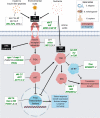Functional conservation in genes and pathways linking ageing and immunity
- PMID: 33990202
- PMCID: PMC8120713
- DOI: 10.1186/s12979-021-00232-1
Functional conservation in genes and pathways linking ageing and immunity
Abstract
At first glance, longevity and immunity appear to be different traits that have not much in common except the fact that the immune system promotes survival upon pathogenic infection. Substantial evidence however points to a molecularly intertwined relationship between the immune system and ageing. Although this link is well-known throughout the animal kingdom, its genetic basis is complex and still poorly understood. To address this question, we here provide a compilation of all genes concomitantly known to be involved in immunity and ageing in humans and three well-studied model organisms, the nematode worm Caenorhabditis elegans, the fruit fly Drosophila melanogaster, and the house mouse Mus musculus. By analysing human orthologs among these species, we identified 7 evolutionarily conserved signalling cascades, the insulin/TOR network, three MAPK (ERK, p38, JNK), JAK/STAT, TGF-β, and Nf-κB pathways that act pleiotropically on ageing and immunity. We review current evidence for these pathways linking immunity and lifespan, and their role in the detrimental dysregulation of the immune system with age, known as immunosenescence. We argue that the phenotypic effects of these pathways are often context-dependent and vary, for example, between tissues, sexes, and types of pathogenic infection. Future research therefore needs to explore a higher temporal, spatial and environmental resolution to fully comprehend the connection between ageing and immunity.
Keywords: Ageing; Conservation; Immunity; Immunosenescence; Lifespan; Longevity.
Conflict of interest statement
The authors declare that they have no conflict of interest.
Figures





References
-
- Lozano-Durán R, Zipfel C. Trade-off between growth and immunity: role of brassinosteroids. Trends Plant Sci. 2015;20(1):12–9. - PubMed
-
- Lochmiller RL, Deerenberg C. Trade-offs in evolutionary immunology: just what is the cost of immunity? Oikos. 2000;88(1):87–98.
Publication types
Grants and funding
LinkOut - more resources
Full Text Sources
Other Literature Sources
Molecular Biology Databases
Research Materials
Miscellaneous

